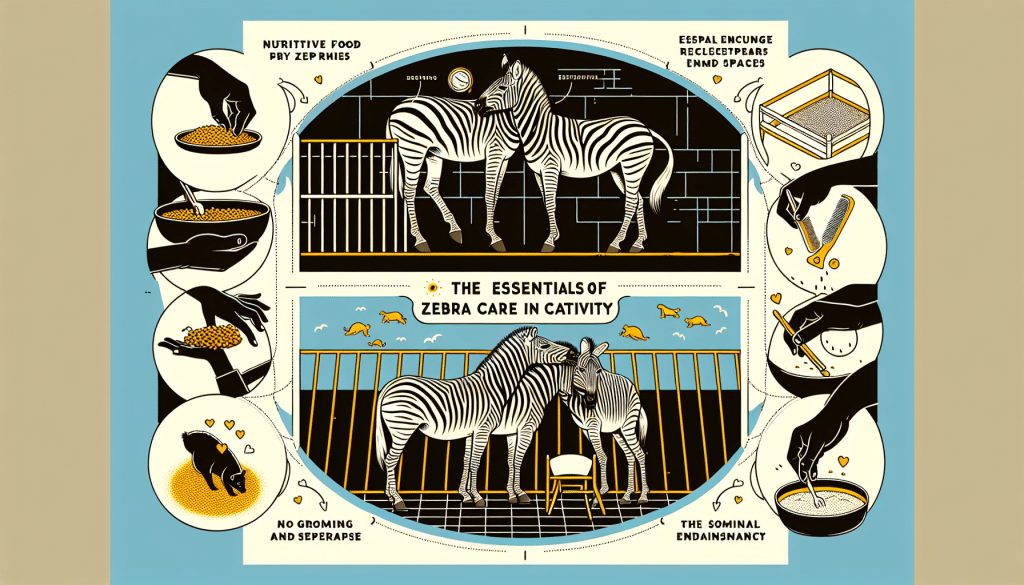So you’ve decided to bring a bit of the wild into your life and become a proud owner of a zebra. Whether you’re an experienced exotic pet owner or a first-timer, this article will provide you with all the essential information you need to keep your zebra happy and healthy. From creating the perfect habitat to ensuring proper nutrition and grooming, we’ll guide you through the ins and outs of zebra care and maintenance. Say goodbye to the mundane and get ready for a truly unique and exciting pet ownership experience!

Understanding Zebra Species
Zebras are fascinating creatures known for their distinctive black and white stripes. Understanding the different species of zebras is essential for proper care and maintenance. There are three main species of zebras: Plains Zebras, Mountain Zebras, and Grevy’s Zebras. Each species has its own unique characteristics and requires specific care.
Distinguishing Between Different Zebra Species
Plains Zebras, also known as Burchell’s Zebras, are the most common type of zebra and can be found in various habitats across Africa. They have broad black stripes and a white belly. Mountain Zebras have vertical stripes on their neck and torso and are primarily found in mountainous regions of Namibia, Angola, and South Africa. Grevy’s Zebras, named after a former French president, have narrow stripes and a white belly. They are larger than the other two species and are mainly found in northern Kenya and Ethiopia.
Behavioral Characteristics of Zebras
Zebras are social animals that typically live in herds, led by a dominant male called a stallion. Within the herd, there is a hierarchical structure, and the females, or mares, usually follow the lead of the dominant male. Zebras communicate through various behaviors, including vocalizations, body postures, and facial expressions. They are also known for their agility and can run at impressive speeds to escape predators.
Habitat Preferences of Different Species
Plains Zebras are adaptable and can thrive in a variety of habitats, including grasslands, savannas, and woodlands. They prefer areas with access to water sources and ample forage. Mountain Zebras, as their name suggests, inhabit mountainous regions with rocky terrain and sparse vegetation. Grevy’s Zebras prefer semi-arid grasslands and deserts, where they have adapted to survive on limited water resources.
Legal Considerations for Zebra Ownership
Owning a zebra is an exciting prospect, but it comes with legal considerations that must be understood and adhered to. It is important to research and comply with all necessary permits, regulations, and laws to ensure the well-being of the animal and avoid legal issues.
Permits and Regulations
Depending on your location, you may need to obtain permits and meet specific regulations to legally own a zebra. These requirements can vary between states, provinces, and countries, so it is crucial to consult with local authorities or wildlife agencies to understand the specific guidelines.
International, Federal, and State Laws
In addition to permits and local regulations, zebra ownership may also be subject to international, federal, and state laws. These laws aim to prevent wildlife trafficking, protect endangered species, and maintain animal welfare. It is essential to thoroughly research and comply with these laws to ensure legal ownership and the well-being of the animal.
Consequences of Illegal Zebra Ownership
Engaging in illegal zebra ownership can have severe consequences. Violating permits, regulations, or laws can result in fines, legal penalties, and even imprisonment. Furthermore, keeping a zebra without understanding its specific care requirements can lead to compromised health and well-being for the animal. It is crucial to respect and abide by the legal considerations surrounding zebra ownership.

Zebra Housing and Environment
Creating a suitable housing and environment for zebras is crucial to their well-being. Providing adequate space, appropriate enclosures, and a stimulating habitat is essential for their physical and mental health.
Space Requirements for Zebras
Zebras require ample space to roam and fulfill their natural behaviors. The specific space requirements will depend on the species and the size of the herd. Generally, a minimum of one acre is recommended per zebra. It is important to ensure a spacious environment to accommodate their social interactions, grazing needs, and exercise.
Types of Enclosure and Fencing
Zebras are known for their agility and can jump over low fences if not properly contained. It is essential to construct secure enclosures and fencing to prevent escapes and protect the zebras from potential harm. Heightened fencing of at least six feet, designed to withstand impact and pressure, is typically necessary. Additionally, ensuring a strong and predator-proof enclosure is important for the safety of the zebras.
Maintaining an Appropriate Habitat
Zebras thrive in a naturalistic environment that mimics their native habitats. Providing a mix of grassy areas, bushes, and trees can offer the zebras opportunities for grazing, shelter, and shade. Regular maintenance of the habitat, such as mowing the grass and removing harmful plants, is necessary to prevent potential health hazards for the zebras.
Diet and Nutrition
Understanding the dietary needs of zebras is crucial for their overall health and well-being. Knowing the appropriate foods, supplements, and feeding schedule is essential to meet their specific nutritional requirements.
Understanding Zebra Dietary Needs
Zebras are herbivores and primarily eat grass and hay. They have a complex digestive system adapted to extract nutrients from fibrous plant material. Providing a diet rich in high-quality grasses, along with occasional legumes and leafy vegetables, can ensure they receive the necessary nutrients, including carbohydrates, proteins, and vitamins.
Common Foods and Supplements
Besides grass and hay, offering zebras fresh water is of utmost importance. Additionally, providing mineral blocks or salt licks can help ensure they receive essential minerals like calcium and phosphorus. It is crucial to consult with a veterinarian or an animal nutritionist to determine if any additional supplements are needed based on the specific nutritional needs of the zebras.
Scheduling Feedings and Watering
Establishing a regular feeding schedule is important for the well-being of zebras. They should have access to fresh water at all times, and their diet should be divided into several smaller meals throughout the day to mimic their natural grazing behavior. Feeding routines should be consistent, ensuring a balance between grazing and nutritional intake.

Health Care and Veterinary Needs
Providing adequate health care and addressing veterinary needs is vital for maintaining the optimal health of zebras. Routine check-ups, disease prevention, and emergency care are essential components of zebra care.
Routine Health Check-ups
Regular health check-ups conducted by a knowledgeable veterinarian are important for monitoring the overall health and well-being of zebras. These check-ups often include physical exams, dental care, hoof checks, and vaccinations. Routine bloodwork and fecal sample analysis may also be recommended to detect any underlying health issues.
Common Zebra Diseases and Prevention
Like any animal, zebras are susceptible to various diseases and health conditions. Some common zebra diseases include respiratory infections, gastrointestinal disorders, and skin conditions. Regular vaccinations, proper nutrition, and maintaining a clean and hygienic environment are key to preventing these ailments. It is crucial to consult with a veterinarian to develop an appropriate disease prevention plan for your zebras.
Emergency Care for Zebras
In the event of an emergency or sudden illness, having a plan in place is essential. It is crucial to have access to a qualified veterinarian who specializes in exotic species or large animals. Familiarize yourself with emergency procedures and basic first aid for zebras to provide immediate care before professional help arrives. Prompt diagnosis and treatment can greatly increase the chances of a positive outcome.
Zebra Behavior and Socialization
Understanding zebra behavior and implementing appropriate socialization practices are essential for the well-being of these social animals. By recognizing their social dynamics, handling with care, and monitoring stress levels, you can ensure a positive environment for zebras.
Social Dynamics in Zebra Herds
Zebras naturally form social hierarchies within their herds, with a dominant male leading and other members following. It is important to respect and understand these dynamics when interacting with zebras. Proper socialization within the herd can be achieved by providing opportunities for group activities and ensuring sufficient space for zebras to interact and establish their social bonds.
Handling and Training Basics
Zebras are intelligent animals, but their training can present unique challenges due to their strong instincts and flight responses. Positive reinforcement-based training methods, applied with patience and consistency, can help establish trust and facilitate desirable behaviors. It is crucial to approach handling and training with caution and seek guidance from experienced trainers or professionals.
Recognizing Signs of Stress and Boredom
Zebras, like any animal, can experience stress and boredom if their social and environmental needs are not adequately met. Signs of stress may include restlessness, increased aggression, or changes in eating and grooming behaviors. Providing mental stimulation through environmental enrichment, such as novel toys or food puzzles, can help combat boredom and promote their emotional well-being.
Grooming and Daily Care Routines
Proper grooming and daily care routines play a pivotal role in maintaining the health and overall well-being of zebras. Regular grooming, hoof care, and maintaining healthy skin and coat are essential aspects of zebra care.
Grooming Tools and Techniques
Zebras benefit from regular grooming, which includes brushing their coat to remove dirt and debris. Soft brushes or grooming mitts can be used to avoid damaging their sensitive skin. Grooming also provides opportunities for bonding and reinforcing trust between the zebra and the caretaker. It is important to approach grooming sessions calmly and patiently, allowing the zebra to become comfortable with the process.
Hoof Care and Management
Zebras, like horses, require regular hoof care to prevent issues such as overgrowth, cracks, or infections. Regular hoof trimming by a professional hoof care specialist, or farrier, is essential to maintain proper hoof health. Adequate footing in the zebra’s enclosure can also contribute to healthy hooves.
Coat Care and Skin Health
Maintaining the health of a zebra’s coat and skin is crucial for their well-being. Regular grooming helps distribute natural oils and remove dirt, promoting a healthy coat. Additionally, providing shelter or shade during extreme weather conditions can protect zebras from sunburn, skin dryness, and other related issues.
Breeding Zebras and Managing Herd Dynamics
Understanding zebra mating patterns and successfully managing the dynamics within a herd are important for responsible zebra breeding. Providing appropriate care for pregnant mares and foals is vital to ensuring the health and well-being of the breeding herd.
Understanding Zebra Mating Patterns
Zebras have specific breeding seasons that vary depending on the species. Breeding typically occurs during the rainy season when food abundance is at its peak. Understanding the natural mating patterns of zebras is crucial for successful breeding, as well as promoting genetic diversity and maintaining healthy herds.
Caring for Pregnant Zebras and Foals
Pregnant zebras require extra care and attention to ensure a safe and healthy pregnancy. Providing a suitable and secure environment for the pregnant mare is essential to minimize stress and protect her and the developing foal. Regular veterinary check-ups and appropriate nutrition are vital during pregnancy. Care for foals includes monitoring their health, ensuring proper nutrition, and facilitating socialization within the herd.
Managing Multi-generational Herds
When managing a multi-generational herd, it is important to maintain a balanced population and prevent overcrowding. Proper spacing, considering the herd’s social dynamics and individual needs, is essential to avoid conflicts. Regular monitoring of the herd’s behavior, health, and reproductive activity can help ensure a harmonious and sustainable herd dynamic.
Exercise and Training
Providing appropriate exercise and training opportunities for zebras is key to their physical and mental well-being. Engaging in stimulating activities and implementing suitable training methods can help keep zebras active, healthy, and mentally stimulated.
Exercise Needs of Zebras
Zebras are naturally active animals and require regular exercise to maintain their physical health. They have high energy levels and are well adapted for running. Providing ample space for them to move freely and engage in natural behaviors is important for their well-being. Encouraging exercise through activities like obstacle courses, chasing balls, or going on walks can help keep zebras stimulated and fit.
Training Methods Suitable for Zebras
Training zebras can be challenging but rewarding when approached with patience and positive reinforcement techniques. Clicker training, target training, and operant conditioning using rewards like food treats can be effective methods for teaching zebras new behaviors and commands. It is important to respect their individual personalities, instincts, and limitations when training them.
Creating Stimulating Activities and Environments
Zebras thrive in stimulating environments that mimic their natural habitat. Providing novel objects, puzzle feeders, or hide-and-seek games can mentally stimulate zebras and prevent boredom. Regularly rotating and introducing new forms of enrichment can keep zebras engaged and promote their overall well-being.
End-of-Life Care and Considerations
Recognizing the signs of aging, providing comfort for elder zebras, and dealing with loss and grief are important aspects when considering end-of-life care for zebras. Ensuring a peaceful, respectful, and compassionate transition is essential.
Recognizing the Signs of Aging
As zebras age, they may experience physical and cognitive changes. Signs of aging can include decreased mobility, weight loss, dental issues, or changes in behavior. Regular monitoring and veterinary check-ups can help identify these signs early and ensure appropriate care.
Providing Comfort for Elder Zebras
As zebras enter their senior years, it is crucial to provide them with a comfortable and low-stress environment. Providing soft bedding, ample shade, and easy access to food and water can help improve their quality of life. Consulting with a veterinarian can help develop a tailored care plan to address the specific needs of elder zebras.
Dealing with Loss and Grief
The loss of a zebra can be a challenging and emotional experience. When a zebra passes away, it is important to provide support and comfort for the remaining zebras in the herd. They may experience grief and exhibit signs of mourning. Understanding their emotional needs and providing them with additional support, such as increased socialization opportunities and comfort from caretakers, can help them cope with the loss.
In conclusion, understanding the diverse aspects of zebra care and maintenance is essential for providing the best possible quality of life for these magnificent animals. From understanding their species and behavioral characteristics to ensuring proper housing, nutrition, and healthcare, responsible zebra ownership requires dedication and knowledge. By respecting their natural behaviors and implementing appropriate care practices, zebras can thrive and bring joy to their owners for years to come.



